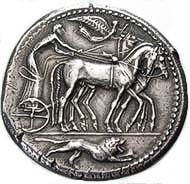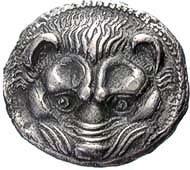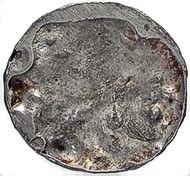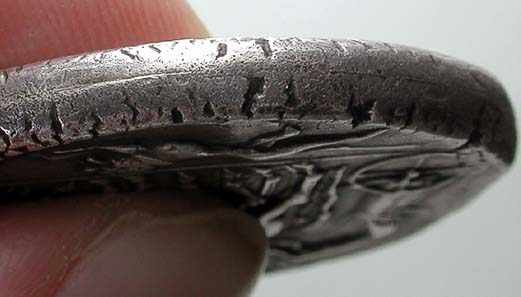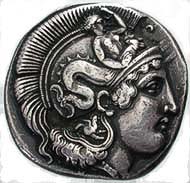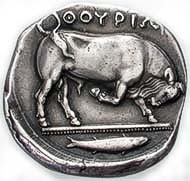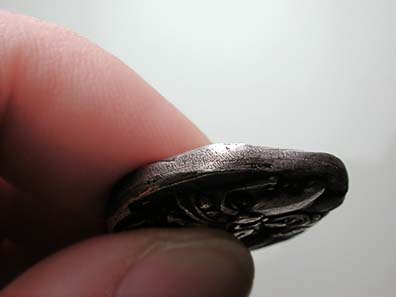by courtesy of the IBSCC
Part 3: Electrotypes
The last two parts on news from the forgery front have dealt with fakes that have been produced by newly cut dies and with cast fakes. This part is dedicated to a third kind of fakes: the electrotypes.
Fig. 1: Electrotype of the British Museum Demareteion.
You will surely recognize the piece on fig. 1. It is one of the very famous decadrachms of Syracuse that are named after queen Demarete, Demareteion. To be even more accurate: this is the Demareteion of the British Museum. This very piece belongs to a series of electrotypes produced for collectors and scholars who were not able to afford a real Demareteion, but who wanted to have a copy of it lying within their coin trays for study purposes. To produce an electrotype you will need an electrolytic fluid and a mould that is covered with a very thin layer of metal. If you conduct electricity through the fluid, the metal within it will deposit on the metal within the mould. The sharper the mould, the better the result with its reproduction. And the results can be impressive.
Fig. 2: Electrotype of the obverse of a Rhegion tetradrachme before having been put together with the electrotype of the reverse.
Normally electrotypes found in old collections were not made to defraud collectors. And they are – as long as they are not tooled like our Demareteion – easily distinguishable. Each electrotype is composed by two halves. Fig. 2 shows one half of an electrotype before being put together with the second half (fig. 2). After this has been done, there will rest a fine, thin weld around the edge of the coin. Each electrotype that has not been tooled shows that weld and is therefore easily recognizable (fig. 3).
Fig. 3: Enlargement of the edge of fig. 1.
But even if these electrotypes were made in the beginning in order to help collectors, some smart businessmen used these imitations in order to deceive unsuspicious buyers. And it is so simple. There are hundreds of ancient pieces showing a tooled edge. If you manipulate the edge of an electrotype, it will be very difficult to recognize the piece as an electrotype. Fig. 4 shows an example. The original of this nomos from Thurium is also to be found in the British Museum. The electrotype was made by the BM and another person tooled the edge in order to make the weld invisible. And he nearly succeeded.
Fig. 4: Electrotype of an Thurium nomos hold by the British museum.
Fig. 5: Enlargement of the edge of fig. 4.
Of course you normally can find out by the weight whether a coin is an electrotype or not, but who of us carries a scale while visiting a coin show? Anyhow, I only can advise you to check routinely the weight of every coin entering your collection. A weight that differs too much from the average weight the coin should have is suspicious.
IBSCC is the abbreviation for the International Bureau for the Suppression of Counterfeit Coins. It was founded in 1975 by the the International Association of Professional Numismatists (IAPN), a non profit organization of the world’s leading professional numismatic firms with 112 members from 23 countries. IAPN members unconditionally guarantee the authenticity of the coins they sell. |





